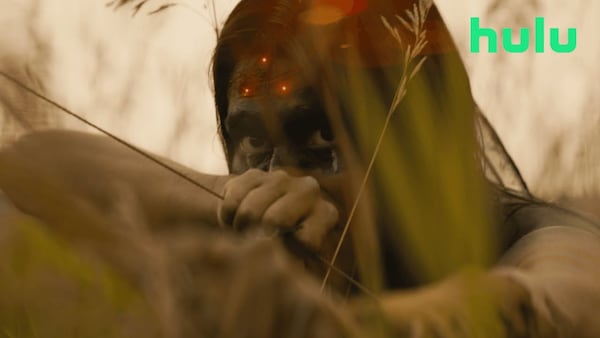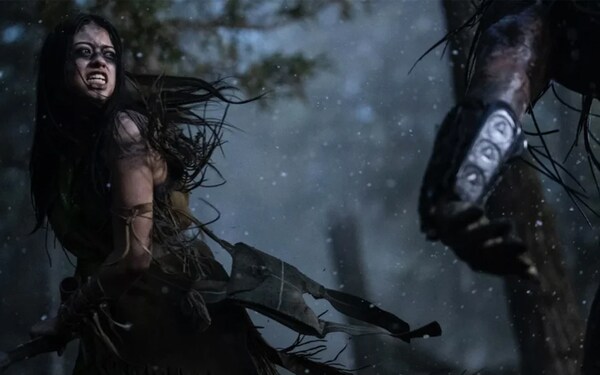Spin-Off: With A Woman As Its Hero, Prey Turns The Tables On The Predator Franchise

- Gayle Sequeira
Film Companion
Last Updated: 10.21 PM, Aug 12, 2022

When Army major Dutch (Arnold Schwarzenegger) first reunites with his old buddy, CIA operative Al Dillion (Carl Weathers) in Predator (1987), they immediately engage in an arm-wrestling contest, a closeup of their muscular, bulging biceps dominating the breadth of the screen (and eventually becoming, as everything must, a-now iconic internet meme.) This snapshot reflects an unchecked machismo and masculine dominance, themes that recur across all installments of the long-running Predator franchise alongside gruesome kills, punishing environments and the pervasive dread that accompanies a hunter’s realisation that they are now the hunted. If the thrill of watching the original Predator lay in how an Alpha male character found himself slotted as the underdog against an apex alien predator, one of the many pleasures of its prequel, Prey (2022), comes from watching the perpetual underdog transform into a hardened Final Girl.
Young Comanche woman Naru (Amber Midthunder) is strikingly unlike any of the other protagonists in the franchise — Armymen, cops, mercenaries — and this perceived weakness is precisely what earns her victory over an advanced species bent on battling only the toughest intergalactic adversaries it can find. Early on, the Predator kills a grizzly bear, preventing it from attacking Naru and aiding her survival. Later, when she’s caught in a foothold trap, it disregards her as a worthy opponent and it spares her life instead of ending it. This turns out to be a fatal mistake. It’s not one the Predator was never in any danger of committing in the original film, in which the cast of military men facing off against it included bodybuilder Schwarzenegger, coming off a string of action movies including Conan The Destroyer (1984), The Terminator (1984) and Commando (1985), and professional wrestler Jesse Ventura. Long before the group sets out into the sprawling wilderness, deployed to rescue a cabinet minister from local insurgents, a scene of them sitting inside a cramped chopper captures the corrosive fumes of toxic masculinity wafting off them. Tensions flare, barbs are traded and inflated egos bristle with rage.
The Predator (2018) attempts to recapture the testosterone-fuelled tension of the original, but in repeatedly burnishing the credentials of its military protagonist, it plays out like a parody of masculinity instead. A much better interpretation of male violence is explored in Predators (2010), in which Army men, mercenaries and murderers assemble once again to fight a trio of predators at an intergalactic game preserve. The film that smartly employs the machismo-driven aggression of these professions to question what it means to be human. How will a group used to preying on their fellow men fare against a common predator? The aliens count on these men turning on the weaker members of the group, using them as bait or abandoning them when they need help. In the sprawling jungle, where the urge to return to one’s baser animal instincts is strong, the group begins suppressing their innate humanity to survive.
To be fair, Naru isn’t the first unlikely hero of the franchise. Predator 2 (1990), which transplants the franchise to the concrete jungles of Los Angeles, centers the action around local cop Mike Harrigan (Danny Glover). His age and fear of heights make him an initially improbable contender for the Predator’s games, especially in this powder keg of a city witnessing power struggles between rival Colombian and Jamaican cartels. The film does, however, sideline its sole woman character, continuing a misogynistic streak that runs through the franchise. Mike’s colleague Leona (María Conchita Alonso) is at the forefront of several firefights, but is simultaneously deemed too weak to consider a potential combatant when the Predator senses that she’s pregnant. Leona exits the frame on a stretcher and never returns. Predators, released 20 years later, features several rape jokes and a camera that lingers on a female soldier’s backside, viewed through her male teammate’s eyes. A character with Tourettes Syndrome appears to be written into the tone-deaf The Predator solely as a pretext to reference female genitalia in vulgar terms. The film’s scientist (Olivia Munn) proves to be adept at wielding a gun but is assigned the more crucial task of babysitting the protagonist’s child.
Prey may be set in 1719, but Naru is very much a protagonist of and for our times. The film converts a series of narrative buzzwords that studios employ as a tickbox exercise — strong female lead, woman of colour, women empowerment — into a thrilling subversion of the franchise’s core DNA. The satisfaction of watching the male members of Naru’s tribe belittle her comes from knowing how wrong they will eventually be. The film exists to vilify, instead of vindicate, the idea of male dominance. Naru’s knowledge of herbs and her insistence on proceeding with a cautious hesitance rather than a muscular bravado are both traits derided as ‘feminine’. And yet, she’d be dead without them.
The movie might inject a well-worn franchise with fresh blood, but it also pulls on the strand of socio-political commentary woven across its installments. The plot of Predator, in which the US military crosses “the wrong side of the border” to conduct its operation in an unnamed South American country mirrored the Iran-Contra affair, in which senior officials of the Reagan administration sold arms to Iran, planning to use the earnings to fund a rebel group in Nicaragua. Audiences returning from watching the film in theatres could tune in to televised hearings of the scandal at home. Questions that Predator raised all those years ago — Who is the invader? Whose land is being invaded? — rebound with special resonance in Prey.
In the film, a herd of skinned buffalo initially seems like evidence of the Predator’s presence but a cigar left carelessly on the ground reveals it to be the work of humans, a species with a boundless capacity for cruelty. A century after the film is set, the US military will attempt to exterminate as many buffalo as they can so as to starve indigenous populations dependent on them. ‘Every buffalo dead is an Indian gone’ becomes a military slogan. Where the other films in the franchise fetishise guns and gun culture, Prey frames the invasion of French fur trappers through their discarded bullets and metal bear traps and, ugly encroachments upon the natural beauty. Naru, who yearns more than anything to be a hunter, knows what it’s like to be hunted. Which is why she knows exactly how to survive.
Prey is currently streaming on Hulu and will release on DisneyPlus Hotstar soon.

 Premium
Premium